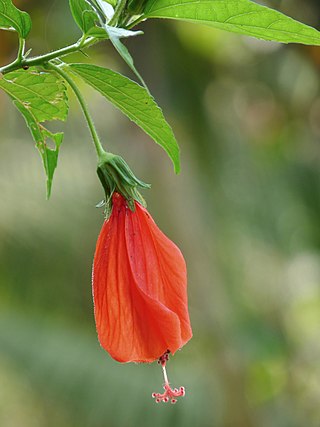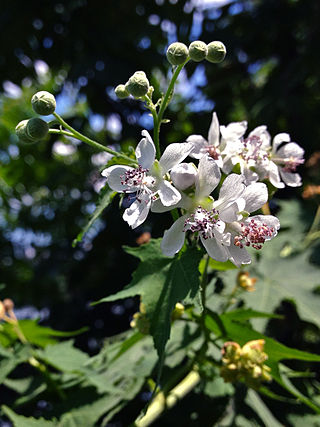
Hibiscus is a genus of flowering plants in the mallow family, Malvaceae. The genus is quite large, comprising several hundred species that are native to warm temperate, subtropical and tropical regions throughout the world. Member species are renowned for their large, showy flowers and those species are commonly known simply as "hibiscus", or less widely known as rose mallow. Other names include hardy hibiscus, rose of sharon, and tropical hibiscus.

Hibiscus syriacus is a species of flowering plant in the mallow family, Malvaceae. It is native to areas of east Asia, but widely introduced elsewhere, including much of Europe and North America. It was given the epithet syriacus because it had been collected from gardens in Syria. Common names include the rose of Sharon,, Syrian ketmia, shrub althea (or simply althea), and rose mallow. It is the national flower of South Korea and is mentioned in the South Korean national anthem.

Hibiscus rosa-sinensis, known colloquially as Chinese hibiscus, China rose, Hawaiian hibiscus, rose mallow and shoeblack plant, is a species of tropical hibiscus, a flowering plant in the Hibisceae tribe of the family Malvaceae. It is widely cultivated as an ornamental plant in the tropics and subtropics, but its native range is Vanuatu.

Malvaviscus is a genus of flowering plants in the mallow family, Malvaceae. Common names for species in this genus include Turk's cap mallow, wax mallow, sleeping hibiscus, and mazapan. It belongs to a group of genera that differ from the closely related Hibiscus in possessing a fruit divided into 5 separate parts, and having a style surmounted by 10, rather than 5, capitate or capitellate stigmas. Among those genera Malvaviscus is distinguished by having auriculate petals and red, fleshy fruits. The generic name is derived from the Latin words malva, meaning "mallow," and viscus, which means "sticky," referring to the mucilaginous sap produced by members of the genus. The fruit can be used to make jelly or syrup. Both the fruit and flowers are used to make herbal teas.

Hibiscus tiliaceus, commonly known as the sea hibiscus or coast cottonwood, is a species of flowering tree in the mallow family, Malvaceae, with a pantropical distribution along coastlines. It has also been introduced to Florida and New Zealand. It has been debated whether this species is native or introduced to Hawaii.

Abelmoschus is a genus of about fifteen species of flowering plants in the mallow family (Malvaceae), native to tropical Africa, Asia and northern Australia. It was formerly included within Hibiscus, but is now classified as a distinct genus. The genus name derives from Arabic meaning 'father of musk' or 'source of musk' referring to the scented seeds.

Physocarpus, commonly called ninebark, is a genus of flowering plants in the family Rosaceae, native to North America and northeastern Asia.

Ostrya virginiana, the American hophornbeam, is a species of Ostrya native to eastern North America, from Nova Scotia west to southern Manitoba and eastern Wyoming, southeast to northern Florida and southwest to eastern Texas. Populations from Mexico and Central America are also regarded as the same species, although some authors prefer to separate them as a distinct species, Ostrya guatemalensis. Other names include eastern hophornbeam, hardhack, ironwood, and leverwood.

Hibiscus coccineus, the scarlet rosemallow, is a hardy Hibiscus species, also known as Texas star, brilliant hibiscus and scarlet hibiscus.

Sida fallax, known as yellow ilima or golden mallow, is a species of herbaceous flowering plant in the Hibiscus family, Malvaceae, indigenous to the Hawaiian Archipelago and other Pacific Islands. Plants may be erect or prostrate and are found in drier areas in sandy soils, often near the ocean. ʻIlima is the symbol of Laloimehani and is the flower for the islands of Oʻahu, Hawaiʻi, and Abemama, Kiribati.
Turk's cap is a common name for several plants and may refer to:

Hibiscus schizopetalus is a species of Hibiscus native to tropical eastern Africa in Kenya, Tanzania and Mozambique. Its common names include fringed rosemallow, Japanese lantern, coral hibiscus, and spider hibiscus.

Physocarpus opulifolius, known as common ninebark, Eastern ninebark, Atlantic ninebark, or simply ninebark, is a species of flowering plant in the rose family Rosaceae, native to eastern North America, named for its peeling multi-hued bark

Sphaeralcea ambigua, is a species of flowering plant commonly known as desert globemallow or apricot mallow, is a member of the genus Sphaeralcea in the mallow family (Malvaceae).

Malvaviscus arboreus is a species of flowering plant in the hibiscus family, Malvaceae, that is native to the American South, Mexico, Central America, and South America. The specific name, arboreus, refers to the tree-like appearance of a mature plant. It is now popular in cultivation and goes by many English names including wax mallow, Turk's cap (mallow), Turk's turban, sleeping hibiscus, manzanilla, manzanita, ladies teardrop and Scotchman's purse; many of these common names refer to other, in some cases unrelated, plants. Its flowers do not open fully and help attract butterflies and hummingbirds.

Suriana is a monotypic genus of flowering plants containing only Suriana maritima, which is commonly known as bay cedar.

Pavonia lasiopetala is a species of flowering plant in the mallow family known by the common names that include Texas swamp-mallow, Wright pavonia, and rock rose. It is native to Texas in the United States and Coahuila and Nuevo León in Mexico.

Thunbergia fragrans, the whitelady is a perennial climbing twiner in the family Acanthaceae, native to South and Southeast Asia and China.

Sida hermaphrodita, known by the common names Virginia fanpetals and Virginia mallow, is a perennial forb native to the eastern United States, which produces white flowers in summer.

















